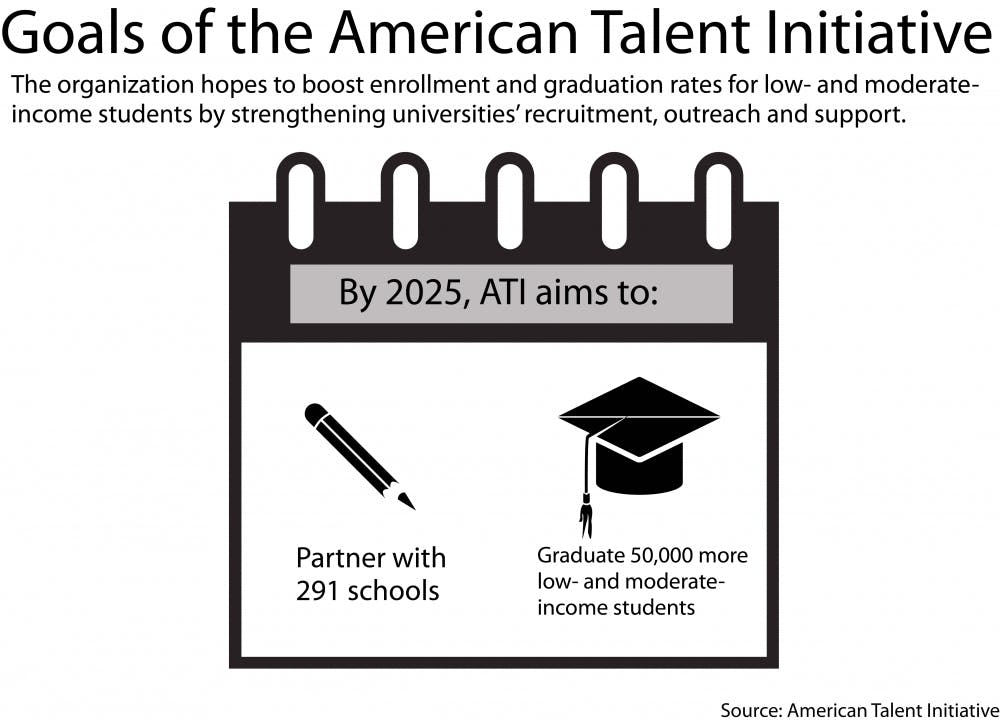At least 12,500 high-achieving low-income students across the country who could get accepted to top-performing colleges and universities each year don’t apply, said Tania LaViolet, co-leader of the American Talent Initiative. That’s the finding that launched ATI, an alliance of top schools devoted to expanding access to higher education for talented low- and moderate-income students. The University became an ATI member in April 2017, according to Dean of Admission Logan Powell.
Founded in December 2016, ATI aims to unite colleges and universities with six-year graduation rates above 70 percent into a consortium dedicated to a common goal: enrolling and graduating 50,000 additional low- and moderate-income students by 2025.
The University joined ATI because the initiative’s national goals align with Brown’s existing institutional goals of expanding socioeconomic diversity and support for low-income students. “The direction we’re heading … is exactly what the American Talent Initiative aspires to do,” Powell said. “It just makes sense to be part of a group of leaders who can come together and talk about ways to continue to move this process forward.”
In just over a year since its inception with 30 founding institutions, the initiative has tripled in size to include 91 colleges and universities, LaViolet said. “We need as many institutions as possible to commit to this work,” she added. The initiative’s membership includes all of the Ivy League as well as public and private universities and small liberal arts colleges.
To join the consortium, schools must set goals for themselves to strengthen outreach and support for low- and moderate-income students. Though each school aims to improve in different areas, ATI focuses broadly on recruiting prospective low-income students, prioritizing need-based financial aid, retaining low- and moderate-income students once they’re on campus and eliminating socioeconomic gaps in graduation rates, LaViolet said.
ATI aims to translate changes at individual institutions into a long-term shift toward more socioeconomic diversity in higher education. “Each institution is going to have their way of contributing,” LaViolet said. “We can achieve more as an alliance than any institution can achieve on its own.”
Since the University’s six-year graduation rate remains consistently high at 95 percent, Powell said Brown’s ATI goals focus largely on enrolling more low- and moderate-income students. As evidence of the University’s commitment to these goals, Powell pointed to partnerships with community-based organizations and programs like Questbridge that help recruit talented low-income students. Other initiatives include the increase in travel funding for this year’s A Day on College Hill and Brown Promise, which will eliminate loans in all undergraduate financial aid packages.
Once low-income students arrive on College Hill, they’re supported by the First-Generation College and Low-Income Student Center, a newly-streamlined emergency fund, financial advising and easy access to administrative faculty, said Dean of the College Maud Mandel. Though retention is not a large problem at the University, Mandel emphasized a commitment to making sure students have the support they need to graduate on time.
Though some recent University initiatives like Brown Promise were already in the works when the University joined ATI, Mandel said the University hasn’t made systemic changes since becoming an ATI member. “In universities, everything takes a while to work through,” she said. “By the end of this academic year, we will have some new initiatives” aimed at improving support for low-income students, she added.
In addition to developing institutional plans for contributing to ATI’s overall goal, ATI member schools are expected to share strategies and data on best practices with one another. When one institution creates a successful program for supporting low-income students, “other institutions don’t have to reinvent the wheel,” LaViolet said. “We can learn what works best from each other.”
ATI facilitates practice-sharing by holding conventions where administrators from different schools can meet, exchange information and brainstorm together. Powell attended one such convention in October 2016.
Mandel said some of her work on new initiatives this year “has absolutely been informed by talking to peers at these schools about the work they’re doing.” For example, she expressed interest in a program at Williams College, another ATI school, that provides textbook funding to students on financial aid. “I don’t think their program is right for us,” Mandel said, but she added that her office is exploring the possibility of developing a similar program for the University.
Other universities plan on contributing to ATI’s goal in different ways.
Steve Nowicki, dean and vice provost for undergraduate education at Duke University, expects that Duke will contribute more to ATI’s practice sharing goals than to its enrollment goals. Nowicki hopes Duke’s Rubenstein Scholar program, which admits and provides support for a cohort of 60 talented low-income, first-generation college students, will serve as a model for other ATI members.
Lehigh University, another ATI member, plans to expand enrollment from 5,100 undergraduates to 6,100 in the next few years, said Bruce Bunnick, interim vice provost of admissions and financial aid at Lehigh. But Bunnick is uncertain Lehigh will see any proportional increase in low-income student enrollment.
Bunnick also expressed concern that ATI schools competing to attract talented students might be reluctant to share best practices with one another, “though I hope that’s not going to happen,” he added.
Mandel said she doesn’t think competition between institutions will hamper cooperation among ATI members. “There’s a lot of talent out there, and there’s plenty of talent to go around,” Mandel said. “We’re far better served by … providing opportunities to the broadest range of students.”
Though it’s too soon to measure the impact of ATI’s collective action, those interviewed expressed optimism and commitment to the initiative’s long-term goal.
“It’s a really urgent need in our country to provide access to the best education to the most meritorious students,” Mandel said. “Brown continues to work on this. There’s still more work to do, and we’re definitely going to keep working on it.”





